The iconic Erzgebirge Toy Museum, workshops where thousands of intricately-carved wooden toys are created each day, gingerbread houses and even a Baroque miner's church — Seiffen in Germany is a true toy town. Kalpana Sunder spends a few wonder-filled days in this magical land
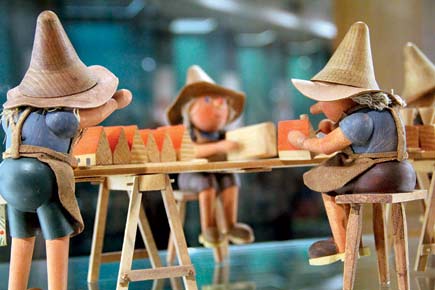
Best From: Munich
Best Time: Christmas and Summer
You need: 2 days
ADVERTISEMENT
Whether you are a believer of Santa Claus or Uncle Scrooge, this scene straight out of a Walt Disney movie will warm the cockles of your heart. Seiffen, tucked into a valley of the Ore mountains close to the Czech border, near Dresden in Germany, is the classic storybook village where it’s always Christmas.
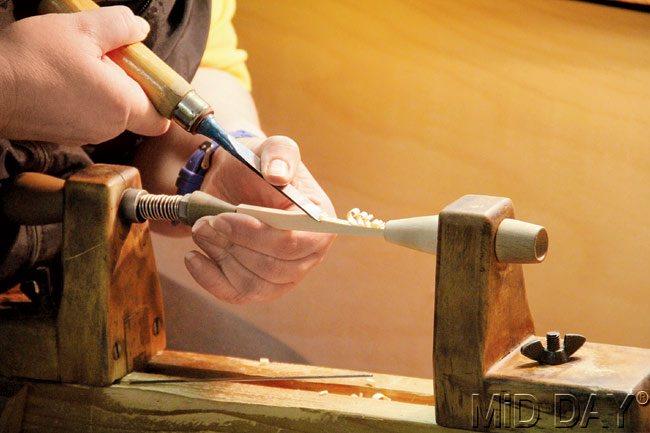
A woodcarver crafts a tree on a lathe in Seiffener Volkskunst. Pics/Kalpana Sunder
All things wooden
This charming village, with wooden gingerbread houses, is the epicentre of wooden toy making with more than 130 family-run businesses churning out wooden toys and Christmas decorations, more efficiently than Santa’s elves. Four centuries ago, the locals were miners, exploiting the region’s rich veins of silver, tin and nickel.
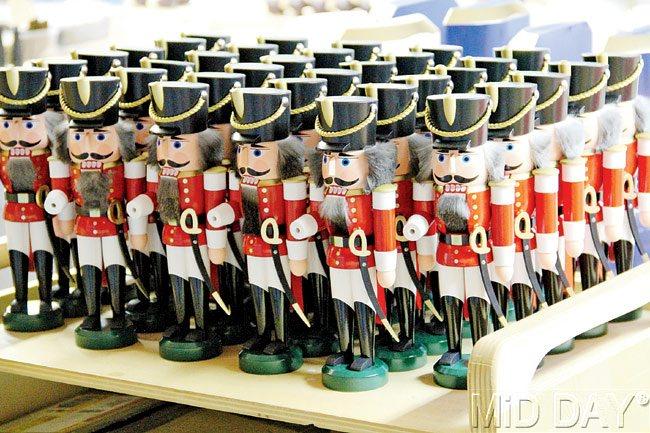
Nutcrackers in a row at a workshop
Woodcarving and toy making were hobbies that the miners indulged in, thanks to the abundant supply of timber from forests. This kept them occupied on long winter nights and they decorated their homes and made toys for their children. The town’s name, in fact, comes from the sieves they used to wash the tin ore.
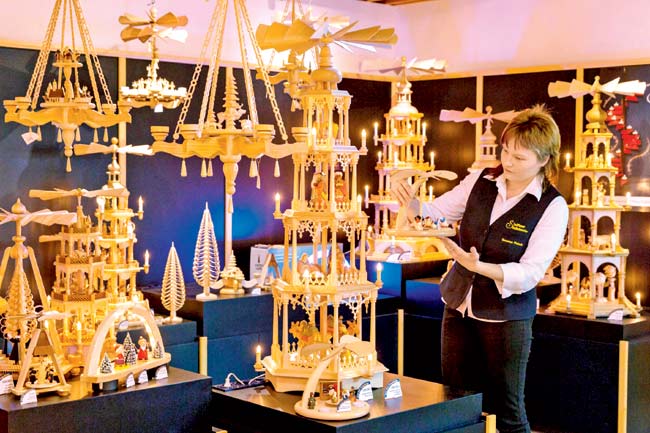
One of the many shops specialising in hand-made, wooden, Christmas decorations in Seiffen, Germany. GETTY IMAGES
When the mines ran dry, the miners converted their hobby into a primary profession. Initially they made wooden toys and furniture; later they developed their craft into attractive Christmas decorations and miniature toys. It was in 1699 that Johannes Friedrich took some wooden products that he has crafted, in a handcart to a trade fair in Leipzig for the first time. The rest is history.

Old wooden toys at the Erzgebirge Toy Museum
An enchanted evening
At the Erzgebirge Toy Museum, I am entranced by the beauty of the hand-carved wooden chandeliers, picture lanterns used by miners, skittles and carousels, Noah’s Ark sets with dozens of farm animals, legions of miniature soldiers and miners, and intricate Nativity scenes.
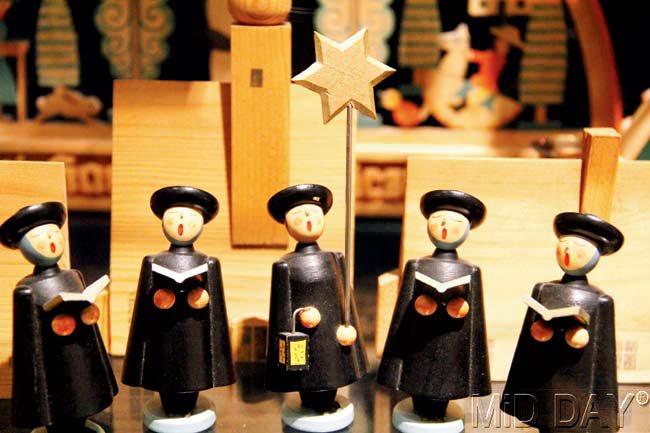
Choir boys carved in wood at the Toy Museum in Seiffen
“It’s all about light... since the miners lived underground and perennially longed for the light they invented the Schwibbogen — wooden arches carved with Nativity scenes, churches and carolers, with candles, that grace windows in these parts,” explains my guide Seema Prakash who has lived in Germany for four years and switches effortlessly between English and German.

One of the charming streets at Seiffen
Legend has it that this was inspired by the pit lamps that the miners would hang on the entrance to the mine pits on their last shift before Christmas. The royal blue and scarlet Nutcracker now synonymous with Tchaikovsky Ballet, invented in 1865, is the classic Seiffen creation — a social commentary woven into toys, where the miners slyly poked fun at authority figures like sheriffs, forest wardens, soldiers and policemen.
Look for signs that read Schauwerkstatt (demonstration workshop) and you can watch how they craft these beauties. I visit the Seiffener Volkskunst showroom-cum-shop, redolent with the smell of sawdust and paint, where we see wooden trees being carved, shaved and curled on lathes under expert hands, a lady putting finishing touches to a fierce Nutcracker and another sew on a white beard on to a toy. “The workers usually take a vocational course that lasts for three years and then, they are picked up by local manufacturers,” says the owner of the workshop. Each person assembles a toy completely from start to finish. Toys like the Nutcracker can have as many as 21 individual pieces and more than 150 ways of putting them together. I love the quirky sense of play that the artistes display: smoking incense holder in the shape of rotund skiers with huge goggles, a cartoonish Santa holding a sack of gifts, sitting on a motor bike and a plump lawyer with his trademark white wig! What impresses me is the attention to the smallest details and the exquisite finish that only handmade craft can accomplish. I learn about the special process where the artisan forms a ring out of a section of tree trunk, working with different depths into the surface of the section. He then slices apart the completed ring, revealing the profile of an animal.
Inside Toy Town
The centrepiece of the town is the octagonal Baroque miner’s church with austere interiors, serene and full of light. The Church was commissioned by the local miners’ association and the Schonberg family, with a lustrous glass chandelier that served as a model for many chandeliers after that and a metal cross made from tin mined locally. As dusk pulls its shutters on the town, I walk up the long Alpine-like street in town lined with metal lamp posts with Christmas motifs. I peek at windows decorated with wooden arches and smiling angels, shops with huge Nutcrackers the size of giants and parades of soldiers and miners. There are delicate tableaus laid out neatly in tiny matchboxes, huge rotating multi tiered Christmas pyramids-wooden stands with candles which heat a pinwheel on top making it spin. Each level brings to life a particular scene like miners working or a nativity scene. Spicy smoke bellows from stalls selling grilled sausages and the heady aromas of gluwein or spiced wine fills the air. I pander to my inner child picking up matchbox tableaus and a quirky smoking man dressed like a postman and watch a mechanical model of a working mine operated by a coin, come alive in a hive of activity underground, against a soundtrack of clanging metal.
My favourite shop is Wendt & Kohn, a family-run enterprise since 1915. It has stunning interiors with blue ceilings embossed with gold stars. The classy shop sells hand-woven folk art with an orchestra of angel musicians, figurines and music boxes that are carved out of the finest wood. At the Buntes Haus Hotel, I attend a cake and storytelling session where the narrative is all about snow and Christmas in the German language. It is largely lost in translation, but the cheery music is universal. Our traditional dinner here is the Neinerlaa or nine things, where each course signifies something special — like lentils for money and red cabbage for health and prosperity . As we drive out of Seiffen, the mist shrouding the streets like a delicate lace curtain, the wooden Schwibbogen shines from the windows, filling me with a warmth that has nothing to do with the mulled wine that I have guzzled.
 Subscribe today by clicking the link and stay updated with the latest news!" Click here!
Subscribe today by clicking the link and stay updated with the latest news!" Click here!






